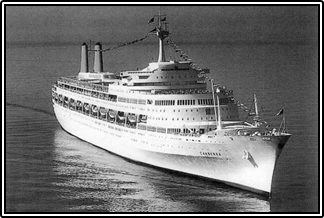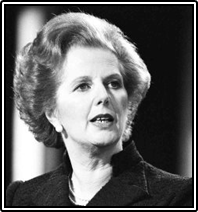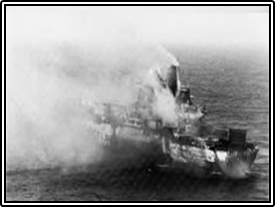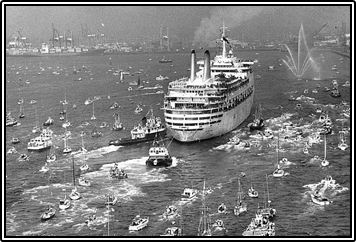S.S. CANBERRA’S FINEST HOUR
Ron Stahl
CLICK HERE TO VIEW IN ORIGINAL PDF FORMAT
 The S.S. Canberra was destined for the breakers after thirty some years of reliable service between the UK and Australia and the loss of passengers from the popularity of new jet airlines. That was, until European travelers found that cruising the Mediterranean was the “in” destination for vacations; thus saving the 825 foot “Great White Whale” (as she was affectionately called) to find her inevitable destiny.
The S.S. Canberra was destined for the breakers after thirty some years of reliable service between the UK and Australia and the loss of passengers from the popularity of new jet airlines. That was, until European travelers found that cruising the Mediterranean was the “in” destination for vacations; thus saving the 825 foot “Great White Whale” (as she was affectionately called) to find her inevitable destiny.
 In the farthest corner of the Earth lay the Falkland Islands. They became the scene of three significant conflicts of the 20th century.
In the farthest corner of the Earth lay the Falkland Islands. They became the scene of three significant conflicts of the 20th century.
During the the Great World War, after his victory over the British Squadron off the Chilean Coast at Coronel, Admiral Graf Spee and his fleet were lured to the Falkland Islands by deception. A communique, supposedly from the German High Command, directed his fleet to Port Stanley. On arriving the British Navy, lying in wait, destroyed Spee’s entire fleet and caused the deaths of Admiral Spee and his two sons.
The second conflict, the “Battle of the River Plate” in World War II, was comprised of British Cruisers operating out of the Falkland Islands engaging the German Pocket battleship Admiral Graf Spee at sea off the coast of Argentina and chasing her up the River Plate to Montevideo, Uruguay. Captain Langsdorff chose to scuttle the heavily damaged Graf Spee rather than subject his crew to certain death by the guns of the British fleet. He then took his own life.
Once again, after years of diplomatic negotiations between Argentina and the UK over the rights to the Falklands Islands, the two countries hit a stalemate.
In March of 1982 reception of major radio traffic on many channels emanating from the South Atlantic caused great concern to Foreign Affairs at Whitehall. There had been reports of observation of high military activity for several days along the coastal ports of Argentina. When reports came of troops being loaded on fast attack vessels, some of the analyzers tried to pass the reports off as “propaganda to the Argentinian people” to distract their minds from the rapid deterioration of their economy and to bolster their “esprit de corps”. However, on April 2, 1982, when a radio message was received from a cargo ship that had seen a large naval armada heading for the combined South Georgia, Sandwich and Falkland Islands, panic in London ensued.
Argentina invaded and captured the Islands. Huge flag-waving crowds flooded the “Plaza de Mayo” in Buenos Aires upon hearing the news of the successful invasion. The Junta reported Argentina’s losses in the operation were one dead and three wounded.
Upon surrendering to the overwhelming Argentine forces, the small Royal Marine detachment and the members of the FIDF (Falklands Island Defence Force), were herded onto the playing fields. Pictures and film were taken of the British prisoners arranged face-down on the ground. When the images were broadcast on television in Britain they incensed the public’s opposition to the invasion. This crisis prompted the resignation of the British Foreign Secretary, Lord Carrigton, for not taking greater heed of the festering affair.
 Margret Thatcher, Briton’s Prime Minister, wasted no time in organizing a wartime committee to engage a plan to defeat the enemy. When challenged by President Ronald Reagan by asking her the reason for waging the war, she reminded him of the historical context, “Just like Hawaii, I imagine. In 1941 when Japan attacked Pearl Harbor; Did America go Cap in Hand for a peaceful negotiations of terms? Those Hawaiian Islands were thousands of kilometers away from the US. No.”
Margret Thatcher, Briton’s Prime Minister, wasted no time in organizing a wartime committee to engage a plan to defeat the enemy. When challenged by President Ronald Reagan by asking her the reason for waging the war, she reminded him of the historical context, “Just like Hawaii, I imagine. In 1941 when Japan attacked Pearl Harbor; Did America go Cap in Hand for a peaceful negotiations of terms? Those Hawaiian Islands were thousands of kilometers away from the US. No.”
An Amphibious Task Group commanded by Commodore Michael Clapp RNC, comprised of the 3rd Commando Brigade, Royal Marines (including units attached from the Parachute Regiment British Army and a number of units under the Royal Armoured Corps) was assembled, This force was loaded aboard the hastily-commandeered cruise liner S.S. Canberra, flag ship of the P&O (Peninsular/Oriental) Line.
Throughout the operation, 43 British Merchant Ships were hastily rerouted from their normal passages, along with their civilian crews, to serve by supplying the Task Group while underway at sea. Cargo vessels and tankers for fuel and water formed an 8,000-mile logistics chain between Britain and the South Atlantic.
When Argentina invaded the Falkland Islands the Canberra was cruising in the Mediterranean. Her Captain, Dennis Scott-Masson, received a message asking his time of arrival at Gibraltar, which, while not on his itinerary, was quickly added. Upon Calling at Gibraltar, he was issued orders that the Ministry of Defence had requisitioned Canberra to be used as a troopship. Canberra sped to Southampton, quickly refitted, and sailed on April 9th for the South Atlantic. Canberra proved vital in transporting troops to the islands more than 8,000 nautical miles away. Meanwhile, much to the indignation of some members of her crew, it was heard that the Queen Elizabeth 2 was held to be too vulnerable to enter the war zone.
On May 6th Canberra left Ascension Island after resupplying and taking on more troops and headed for the Falklands. She anchored in San Carlos Waters (a protected bay within Falkland sound that divided the East and West Falklands) and on May 21st began delivering her passengers, ready for battle.
During the month of May several HMS Navy ships were sunk. HMS Sheffield and HMS Coventry, both destroyers, and the Frigates, HMS Ardent and HMS Antelope.
 The container ship “Atlantic Conveyor” was hit with two Exocet missiles fired from the French- supplied “Super Etendard” jets, killing 12 members of her civilian crew, including her Captain. A raging fire caused the loss of several helicopters intended for the attack on the Argentinians at Port Stanley. Prince Andrew, 2nd in line to the throne, piloted his Sea King helicopter to rescue the rest of the crew.
The container ship “Atlantic Conveyor” was hit with two Exocet missiles fired from the French- supplied “Super Etendard” jets, killing 12 members of her civilian crew, including her Captain. A raging fire caused the loss of several helicopters intended for the attack on the Argentinians at Port Stanley. Prince Andrew, 2nd in line to the throne, piloted his Sea King helicopter to rescue the rest of the crew.
After learning of the loss of the “Atlantic Conveyor” many of the Canberra’s crew felt they would be carrying targets on their backs while sailing the all white “Great White Whale” into San Carlos Waters. The waters were a scene of intense aerial combat, as the Argentine “Super Etendard” jets with their Exocet missiles were playing havoc with the landing forces and damaging many support vessels.
Canberra had done her job landing around 2000 troops without a casualty and without getting hit herself.
She was not finished yet, but she was lucky to be alive. How the Argentine pilots could have missed the all-white ship was one of the day’s mysteries. It was said that orders from the Argentine high command forbade their firing on the ship, thinking she was a hospital ship, even though it was obvious to the Argentine pilots that she was discharging troops.
The QE2 had also been requisitioned as a troop ship and was heading south to rendezvous with Canberra at Grytviken in the South Georgia/Sandwich Islands to cross-deck 3,000 of her troops. Canberra weighed anchor and headed back to San Carlos Water in the Falklands, discharging those troops, while the QE2 sailed back to Ascension and then on to England.
An incident that also soured Canberra’s crew to the QE2 happened after the transfer of troops from QE2 at South Georgia. The QE2 failed to transfer the slop chest and canteen goodies: beer, sodas, cigarettes, candies, playing cards, etc., and the troops had to share Canberra’s meager supply.
After the surrender of the Argentine Military Command, Canberra was was once again called on to transport troops; this time the order was the great “honor” of transporting several thousand Argentine prisoners of war to Puerto Madryn, Argentina.
Her proudest moment came, when she was ordered back to the Falklands to take aboard the weary combat troops and head for home.
Canberra’s approach to the port of Southampton was overwhelming; hundreds of vessels vying to get close enough to congratulate the troops and many thousands of people along the quays and docks, full of enthusiasm, singing their hearts out and waving flags.
The troops crowded the rails and responded by singing, “Rule Britannia” and “Soldiers of the Queen” loud and in unison as if being led by a grand maestro, their foot stomping and drums kept the beat loud and clear.

(POST SCRIPT)
Canberra was refurbished and returned to cruising the Mediterranean. Everyone wanted to book their cruises on the most glorious ship afloat at the time. This lasted for several years. However, competing with newer liners, coupled with the cost of operating and maintaining the 36 year matron, signaled her end. Her maiden voyage was June 2, 1961 and her final voyage was on October 31, 1997. After 36 years she was scrapped (what a horrible word for the end of such a proud lady) at the Gadani Ship-Breaking Yard in Pakastan.
Many years ago, my wife and I, while on a cruise to Port Stanley met an Engineer who was on the Canberra during the Falklands War. He was the most gregarious person we ever met and kept us entertained with anecdotes of his life at sea, including his time on Canberra. His exploits stayed with me, and are the basis for this article.
In the Memorial Complex on East Ross Road are walls of bronze placards with many names of Military units and those who perished in the conflict. What was interesting was the monument and plaque in memory of the World War I defeat of Admiral Graf Spee and his fleet.
Another interesting observation was a Mariner’s plaque of honor. Britain has always recognized her Merchant Mariners, the Brits survival always depended on them.
It took America 33 years to recognize our Mariners of WWII, after most had already passed on.